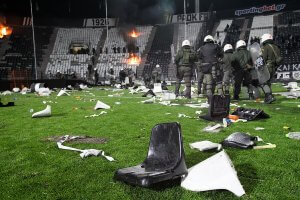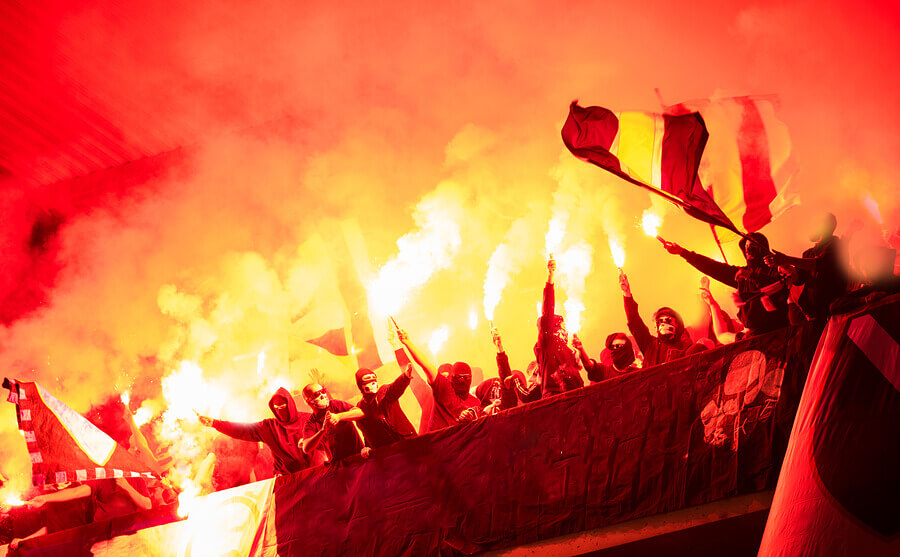Violence in Sports: Criminal Law

In 2003, after a season full of violence in sports and at sports venues, the government of Spain announced its intention of reformulating the Criminal Code. The goal was to provide the right level of punishment for the offenses committed in sports venues. Also, the government wanted to regulate the behavior of sports fanatics and attendees at this kind of event.
In practice, this decision was influenced by many factors, but especially social pressure. The government felt it was necessary after the serious incidents that occurred during a soccer match in Castellón in 2003. This incident ended with severe aggression against the referees and the death of Coruña fan Manuel Ríos Suárez.
However, much of the civil society and its political representatives agreed with the need to reformulate the Spanish Criminal Code for different reasons. One of them was the acknowledgment of the alarming increase of violence in sport.
This, coupled with the knowledge that whatever crime committed would go unpunished, made it necessary to reform the law. Up until this point, the laws with criminal content in Spain didn’t really consider violence in sport as a crime.
Violence in sports is now a punishable crime in Spain
After the incident in Castellon, people were upset and worried. The same year, the then Minister of Education, Culture, and Sports, Pilar del Castillo, announced that the government was taking due steps to reformulate the Spanish Criminal Code. They launched the new project surprisingly fast, describing what the law would, from then on, consider violence in sport.
In this regard, the law now understood as violent acts in sport would encompass not only the actions that occurred within the playing fields. Violence in sports also includes violence taking place in the surroundings of sports venues. This was an important advance in the field of criminal law applicable to sport. Until 2003, at least in Spain, the law focused on the events that occurred only inside sports venues.
In fact, the official intention was to generate a modern and easily applicable text. It was about optimizing security strategies and measures in all public events held in the national territory.

Violence in sports needs regulation by official and sports organizations.
On the one hand, specific penalties are in place to punish crimes of violence in sports. In this sense, the law now imposes stricter obligations on clubs that organize events in their properties, especially regarding security.
From this reform in the Penal Code, it would begin to be possible to determine prison sentences ranging from six months up to six years. This would apply to people who incurred in crimes related to violence in football sports venues.
But prison wasn’t the only fitting penalty for sports criminals. Another sentence was the deprivation of participation in sports events for up to six years. This was a fitting and harsh sentence for those sports fanatics.
Violence in sports within the field of play
Inappropriate or violent behaviors in the field and behaviors that go against the rules are often subject to a sanctioning process. Certain institutions handle the sanctions and determine the appropriate course to follow. These are the regulating institutions, whose job is to make sure every team, federation and sports association is on the same page when it comes to rules. As a general rule, the Federal Disciplinary Committees are responsible for imposing disciplinary actions.
Soccer is one of the strictest sports when it comes to disciplinary actions. In Spain, there are three different institutions that regulate and evaluate the incidents relating to soccer. These institutions are regulated by the FIFA, the International Federation of Football Associations.
The first person who determines if a player deserves a sanction or not is the referee. After this, the Competition Committee gets to check the infractions and reviews them to establish the appropriate sanctions. The inappropriate behavior of each player and the rules of the game will determine the sanction.
The majority of crimes regarding violence in sports used to be handled by sports associations. However, this wasn’t enough, because these associations couldn’t penalize fans and spectators. Since the Sports Law reformulation, Spain can now penalize many more cases of violence happening inside and around a sports venue.

Injuries during sports competitions in criminal law
Injuries during sports competitions are a particularly atypical case within Spanish criminal law. This is especially particular when the sanction determined at the administrative level seems not to account for the seriousness of the violent event that occurred in the sports field, and its consequences for the career and life quality of the athlete.
The complexity of these cases derives from the fact that sports injuries don’t appear in criminal content laws in Spain. The article 428 of the Criminal Code, which deals broadly with crimes of physical injury, doesn’t even mention them. This text even deals with very sensitive issues in the field of health, such as organ transplants.
Cases such as this reveal the limitations of the application of criminal law in the field of violence in sport. This is especially true when violence occurs within the playing field and fanatics try to challenge the official regulations.
In 2003, after a season full of violence in sports and at sports venues, the government of Spain announced its intention of reformulating the Criminal Code. The goal was to provide the right level of punishment for the offenses committed in sports venues. Also, the government wanted to regulate the behavior of sports fanatics and attendees at this kind of event.
In practice, this decision was influenced by many factors, but especially social pressure. The government felt it was necessary after the serious incidents that occurred during a soccer match in Castellón in 2003. This incident ended with severe aggression against the referees and the death of Coruña fan Manuel Ríos Suárez.
However, much of the civil society and its political representatives agreed with the need to reformulate the Spanish Criminal Code for different reasons. One of them was the acknowledgment of the alarming increase of violence in sport.
This, coupled with the knowledge that whatever crime committed would go unpunished, made it necessary to reform the law. Up until this point, the laws with criminal content in Spain didn’t really consider violence in sport as a crime.
Violence in sports is now a punishable crime in Spain
After the incident in Castellon, people were upset and worried. The same year, the then Minister of Education, Culture, and Sports, Pilar del Castillo, announced that the government was taking due steps to reformulate the Spanish Criminal Code. They launched the new project surprisingly fast, describing what the law would, from then on, consider violence in sport.
In this regard, the law now understood as violent acts in sport would encompass not only the actions that occurred within the playing fields. Violence in sports also includes violence taking place in the surroundings of sports venues. This was an important advance in the field of criminal law applicable to sport. Until 2003, at least in Spain, the law focused on the events that occurred only inside sports venues.
In fact, the official intention was to generate a modern and easily applicable text. It was about optimizing security strategies and measures in all public events held in the national territory.

Violence in sports needs regulation by official and sports organizations.
On the one hand, specific penalties are in place to punish crimes of violence in sports. In this sense, the law now imposes stricter obligations on clubs that organize events in their properties, especially regarding security.
From this reform in the Penal Code, it would begin to be possible to determine prison sentences ranging from six months up to six years. This would apply to people who incurred in crimes related to violence in football sports venues.
But prison wasn’t the only fitting penalty for sports criminals. Another sentence was the deprivation of participation in sports events for up to six years. This was a fitting and harsh sentence for those sports fanatics.
Violence in sports within the field of play
Inappropriate or violent behaviors in the field and behaviors that go against the rules are often subject to a sanctioning process. Certain institutions handle the sanctions and determine the appropriate course to follow. These are the regulating institutions, whose job is to make sure every team, federation and sports association is on the same page when it comes to rules. As a general rule, the Federal Disciplinary Committees are responsible for imposing disciplinary actions.
Soccer is one of the strictest sports when it comes to disciplinary actions. In Spain, there are three different institutions that regulate and evaluate the incidents relating to soccer. These institutions are regulated by the FIFA, the International Federation of Football Associations.
The first person who determines if a player deserves a sanction or not is the referee. After this, the Competition Committee gets to check the infractions and reviews them to establish the appropriate sanctions. The inappropriate behavior of each player and the rules of the game will determine the sanction.
The majority of crimes regarding violence in sports used to be handled by sports associations. However, this wasn’t enough, because these associations couldn’t penalize fans and spectators. Since the Sports Law reformulation, Spain can now penalize many more cases of violence happening inside and around a sports venue.

Injuries during sports competitions in criminal law
Injuries during sports competitions are a particularly atypical case within Spanish criminal law. This is especially particular when the sanction determined at the administrative level seems not to account for the seriousness of the violent event that occurred in the sports field, and its consequences for the career and life quality of the athlete.
The complexity of these cases derives from the fact that sports injuries don’t appear in criminal content laws in Spain. The article 428 of the Criminal Code, which deals broadly with crimes of physical injury, doesn’t even mention them. This text even deals with very sensitive issues in the field of health, such as organ transplants.
Cases such as this reveal the limitations of the application of criminal law in the field of violence in sport. This is especially true when violence occurs within the playing field and fanatics try to challenge the official regulations.
All cited sources were thoroughly reviewed by our team to ensure their quality, reliability, currency, and validity. The bibliography of this article was considered reliable and of academic or scientific accuracy.
- Código Disciplinario de la Real Federación Española de Fútbol. 2015. Extraído de: https://www.rfef.es/sites/default/files/pdf/CODIGO-DISCIPLINARIO-TEMPORADA-2014-2015-(enero-15).pdf
- Rodríguez, J. El seguidor del Deportivo murió al ser atacado por un miembro de Riazor Blues. 2003. El País. Extraído de: https://elpais.com/diario/2003/10/09/deportes/1065650402_850215.html
- Sanciones y acciones del Comité de Competición. Federación Española de Fútbol. Extraído de: https://www.rfef.es/tags/comit%C3%A9-de-competici%C3%B3n
This text is provided for informational purposes only and does not replace consultation with a professional. If in doubt, consult your specialist.








